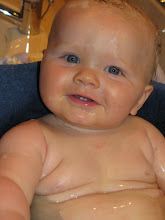
Here--perhaps--we have two lovers, both in the full bloom of blushing youth. Their unadulterated freshness matched only by the crisp, newness of the salad greens that the enraptured female is attempting to toss. While she, at least, still maintains a semblance of attention to the meal's preparation, the male has abandoned all interest in the vegetarian dish. Instead, his carnivorous desires have drawn him to the flesh of his beloved's exposed neck. With his arms wrapped around her midsection, he appears to be smelling her—either tenderly inhaling the scent of her shampoo or sniffing at her sweat as a canine may do in investigating another. Husband, vampire, or dog...your guess is as good as mine.
In creating my word picture I willfully and intellectually choose combinations of words to express my thoughts. Now, I will take a semiotic approach in examining the language of my word picture. According to Ferdinand de Saussure's Course in General Linguistics, “In separating language from speaking we are at the same time separating: (1) what is social from what is individual; and (2) what is essential from what is accessory and more or less accidental” (Saussure 59). Semiotics is concerned with the “social side of speech,” specifically Saussure defines it as the study of “life signs within society” (60). A sign, in this case a linguistic sign, consists of the signified or the concept and the signifier or the sound-image (62). In the first sentence of my word picture I decided to describe the male and female in the image as “lovers,” lovers being the signifier and the male and female being the signified. The relationship between the signifier and the signified is arbitrary, thus I could have chosen any number of terms to replace “lovers.” I settled upon “lovers” by comparing the term with other “words that stand in opposition to it.” As Saussure explains, “words used to express related ideas limit each other reciprocally;” I selected “lovers” by evaluating the term against similar ones such as friends, soul mates, buddies. Had none of these similar terms existed, “lovers” would not have been imbued with the value that it has. The value of “lovers” in comparison to friends is that the relationship it connotes seems stronger, more passionate; against soul mates “lovers” seems to imply a less serious relationship that emphasizes sexual chemistry. Words do not stand for pre-existing concepts. When I use a word to signify “something when I have in mind the associating of a sound-image with a concept...“as I did with lovers for the male and female in the image...“I am making a statement that may suggest what actually happens, but by no means am I expressing the linguistic fact in its essence and fullness” (68). It is possible to manipulate and take advantage of the fact that individual expressions never completely capture the concept and that these varied interpretations and expressions are often interchangeable.
I employed the words that I did because there was a predatory commercialness to the image. Everything is perfect and shiny and new and clean--'Hallmark' happiness. The man wears a ring on his left hand, a symbol of marriage and eternity and security. His arms are wrapped around the female's waist; he is the protector of the weaker sex. I saw irony and perversity in this embrace. It is too phony and stereotypical. To me it seemed like he was exerting his force of ownership; objectifying the woman—mine, mine, mine—almost to the point of consuming her. I also thought the idea of consuming her echoed nicely of consumerism, commenting again on the commercial emptiness of the image. I used signifiers such as fresh, young, and tender because these concepts seem to be the ones aimed at by a commercial image especially one representing the ideal of “young” love. Again by comparing the terms with ones that stand in opposition the reason for my word choice becomes clearer. The image would be entirely different and definitely not as resoundingly commercial had the “lovers” or the “greens” been old, withered, and rotten. In the concluding sentence of my word picture, I exaggeratedly compared the male in the picture to a vampire and a dog. I wanted to comment on the aspects of the image that sickened me--namely the commercialization of love and youth and the sexist, stereotypical representation of gender roles. The comparison works because these signifiers though they are worlds away from “lover” and “husband” still conjure up aspects of the signified image. The male is ogling her neck as a vampire might do, he also seems to be carnally inhaling her scent as a dog might. The terms vampire and dog connote an entirely new set of meanings and attitudes. In using these words I am assigning a a new and different value to the symbols that this image represents. The patriarchal, consumerist message of the image is not innocent, healthy, fresh or ideal. In my opinion it is blood-thirsty, beastly, uncivilized and dangerous. The exchange of the signifiers from “lover” to “husband” to “vampire” to “dog” communicates my distaste for the politics behind this image.


Very nice defamiliarization! You really described the photo and not the intention very nice.
ReplyDeleteduane